by Michael Cropper | Sep 19, 2015 | SEO |
To put things into perspective, let’s look at the handy tools we have on our personal computers for monitoring computer resource usage. If you’re on a PC then you can easily view the Performance data within your Task Manager and I’m sure there is something similar for you Mac users out there;
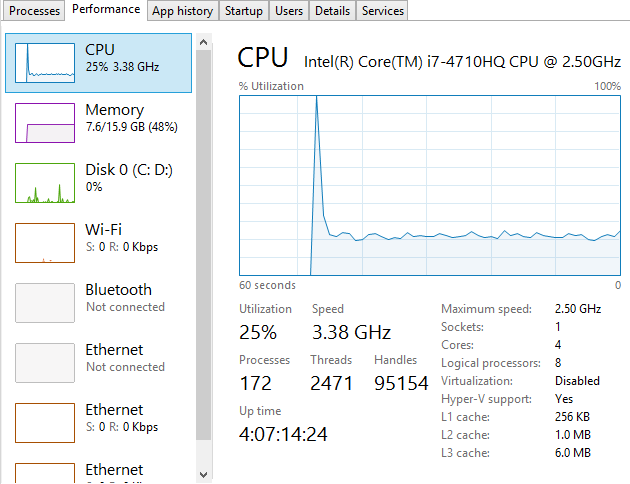
This is a very handy little tool which clearly shows you how your personal computer is performing and how things perform when you start to open new applications such as Microsoft Word or the memory eating Google Chrome browser. Here’s what happens when you kill Google Chrome after you have closed the application;

Interesting to say the least…
Anyhow, the point here is that monitoring the performance of your personal computer is relatively simple if you know where to look. Now we’re going to look at how to monitor your web server resources accurately using a suite of tools and also look at the significant differences between how different tools report on how many resources have been used and how many are free to use. The differences are what we are going to be focusing on as they are huge and can lead you to believe that you actually have more resources available than you really do.
Web Server Resources
Before we jump into monitoring your web server resources, let’s just define this. Essentially the key resources related to your web server include;
- CPU – The quantity of CPUs and their processing power in total.
- RAM – The quantity of memory currently in use and free for other things. Plus the quantity of RAM reserved for buffering and caching.
- Hard Disk Drive Space – The number of GBs of data you are using compared to the size of your disk.
- Disk I/O Utilisation – The number of input/output connections to the hard drive per minute which again has a limit
- Network I/O Utilisation – The amount of traffic on your physical network infrastructure
Behind all of these key metrics includes an enormous amount of information about the software that is running on the hardware and which processes are hogging these physical resources. This is where web server monitoring software comes in to its own as this can provide you with some extremely powerful data about how your web server is performing and most importantly, when you need to look at upgrading your web server to cope with the demands of the website or websites that are hosted on the web server.
Just as with your personal computer, web servers have a limit which needs to be managed effectively. If you tried to open 1000 Google Chrome browser tabs, your computer would probably grind to a halt as the physical hardware resources would be pushed over their limit. To the point where you would probably have to reboot your computer to resolve the problem. Your web server is no different, it’s just a little more complex, doesn’t have a physical button you can turn it on/off with (or kick!) and is sat in a huge data centre somewhere, ours are in Manchester & London.
When running a web server, it is clearly a little more important than your personal computer as this contains your website, the digital front of your business which is why it is essential to do everything physically possible to work towards a near 100% up-time. I’ll not cover today about why a 100% up-time is impossible to achieve and any guarantees of this are a flight of fancy, instead today we’re going to look at how to monitor your web server resources accurately using a suite of tools, specifically New Relic and Munin.
New Relic
We use New Relic on our web servers because it is extremely user friendly (well it is for someone of a technical nature compared to the other tools we have to work with). Being able to easily graph server resource usage to the n’th degree.
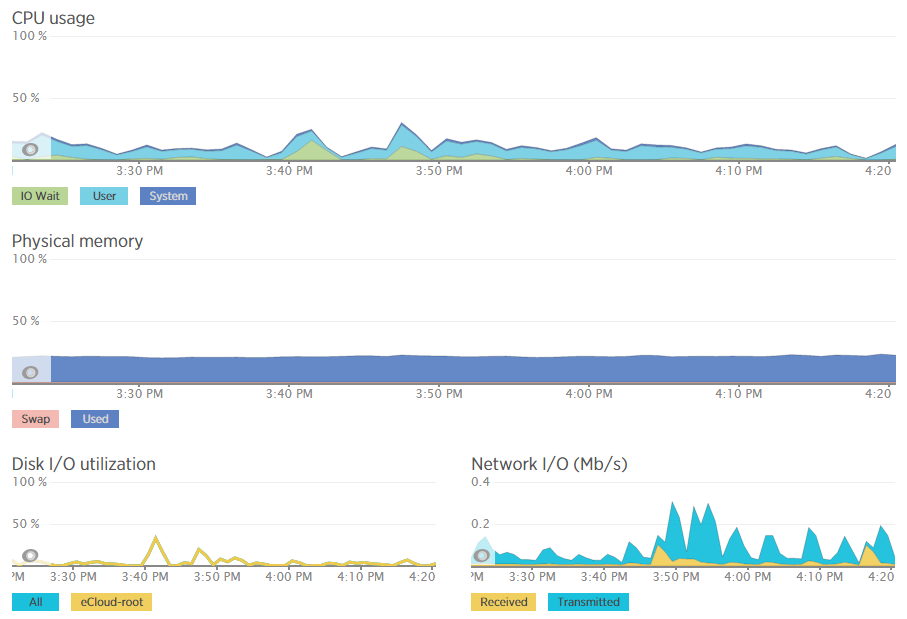
Which then further breaks this data down into the different processes that are using the resources, which websites hosted on the server are using the resources and also which user accounts are using the most resources and so on. Going beyond this, New Relic also allows us to monitor the up-time of our servers which is extremely useful for us to continually improve the performance of our servers over time;

As mentioned previously, a 100% up-time is almost impossible to achieve due to various reasons which we’ll cover in another blog post. As you can see in August and September, the server has been performing exceptionally well overall but has had a couple of blips which we’ve worked to improve performance following this. The important aspect here is that we are tracking this data which means that we are capable of acting on these insights we have to continually improve the service to our customers. We already use industry leading server technology which can always be improved further by actively monitoring performance and improving areas which need attention.
What is interesting with the New Relic data though is that the memory usage data isn’t quite as accurate as it seems on first glance which is due to the way Linux organises data at the operating system level to improve performance. By default, Linux see’s RAM as wasted space if it isn’t used so it looks to utilise the available RAM to speed up performance. This is great in theory, although can cause a few issues if not carefully managed. Accessing data from RAM is up to 1000 times faster than accessing the same data from a hard drive which is why RAM is such a powerful way to increase the performance of technologies and hence make your website load faster. It’s a shame that it’s so expensive to purchase in comparison. I guess we’ll just have to wait for the next wave of hardware innovations to break through this barrier. Specifically related to server management and New Relic, the underlying way Linux classifies available RAM compared to how New Relic reports on this data isn’t quite accurate which can be misleading.
For example, when analysing one of the blips we had recently, at either side of the troublesome time, server resources within New Relic were being reported at well below 30% usage for CPU and well below 40% usage for RAM;
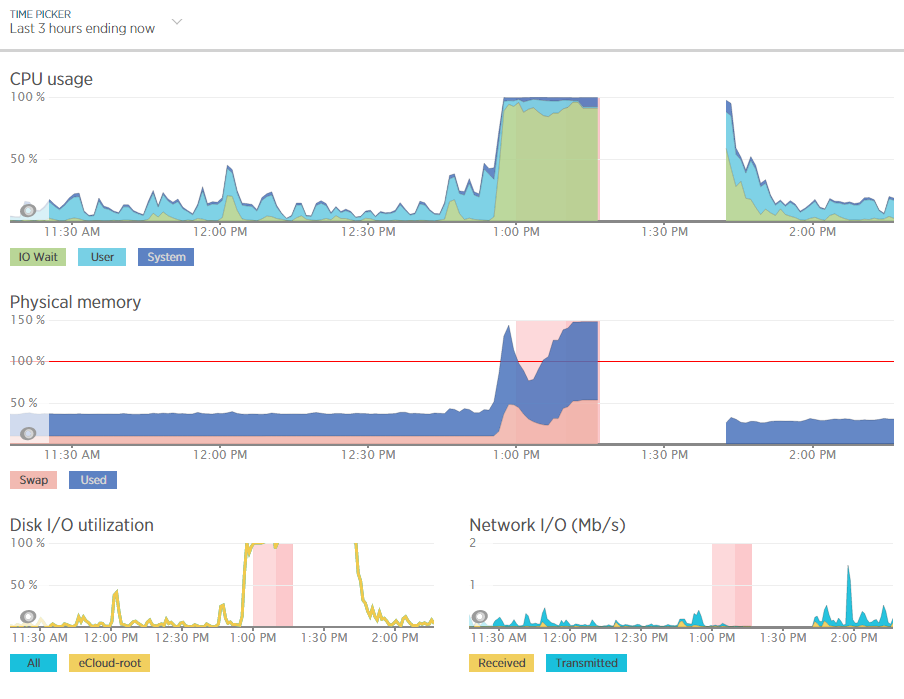
Although the blip happened for a specific reason which we needed to get to the bottom of this so we could prevent this happening again. Thankfully we have multiple tools at our disposal which allowed us to fully investigate the issue and take the necessary steps.
Using external tools is a great way of reporting on performance although they are external from the system and they may be reporting on data in a slightly different way. So we investigated this going back to the command line interface and logging into the server via SSH & PuTTY to query the server directly to get some more accurate information. What we found was rather interesting. When querying the server directly to see how much memory was being used this highlighted that the performance data within New Relic was actually quite a way off when it comes to its accuracy;

Here we see that there is only 300MB of RAM free out of 2GB opposed to the 60% free which equates to around 4x this figure at 1.2GB which is being reported in New Relic. Quite a difference here. The difference relates to the Buffer / Cache data which is being used by Linux to speed up the web server yet isn’t being taken into account by New Relic. While this is a nice setup to have, this does have its own performance issues when spikes occur which can lead to problems as outlined earlier.
Doing a one-off report for server resource usage via the command line is nice, but it is only a snapshot so doesn’t report on the true performance of the server over time. Thankfully we use another web server monitoring tool called Munin which essentially does a similar thing and much more then graphs all of this data over time.
Munin
Here is where the open source technology Munin comes in. Good old open source projects providing more insight than enterprise level software yet again. This is not a dig at New Relic as this software is really good, more of another stripe on the open source community for being so awesome.
Munin is designed to report on how your web server is performing in a similar (but not as pretty) way as New Relic. When looking at the same data within Munin as what we were looking at within New Relic the data was clear to identify what caused the issue;
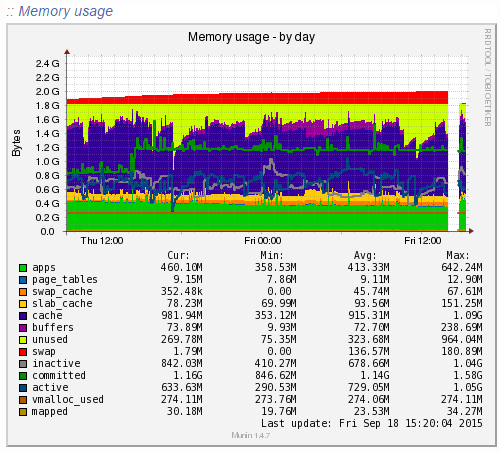
Ok, clear to me… What the above graph is showing can be summarised as;
- Red: This is the memory swap data which is outlined in more detail below. Importantly, this memory swap data is also highlighted on the New Relic graphs.
- Yellow: This is the available RAM
- Purple: This is the cached data sitting within the RAM. From New Relic’s point, this is available RAM, although from a physical hardware point, if we want to access this space we first have to clean something out, retrieve the data from the hard drive then add the data back in to RAM which consumes a large amount of processing power on the CPU
- Green: This is the memory taken from the applications in use on the web server
Note on the Red data in the graph above, the Memory Swap. What is actually happening here is that Linux is deciding what files to move in and out of memory based on what it thinks are the most important files. This work takes up valuable resources which is why the CPU levels and the Disk I/O levels on the New Relic graphs above spike right when this hits its peak. This is essentially the web server scrambling to optimise the performance at the detriment of its overall health. It’s the same as when you push yourself physically too much and then become ill from the process and need a rest. It’s the web server doing the same thing. When you start to see an increase or a significant amount of memory swap data within your New Relic graphs, I’d recommend checking to see what is really happening at the server level as this essentially highlights that your web server needs a bit more RAM or that you need to optimise the way Linux utilises the memory;

What all of this highlighted is that we needed to notch up the RAM on this server a bit. The aim was to increase the available RAM to allow for a greater amount of unused RAM meaning that the CPU nor the hard drive wouldn’t have to work as hard to access the information needed. As you can see, when we increased the RAM around 3pm in the above graph, the memory usage percentage went down within New Relic. As we know though, the New Relic data isn’t 100% accurate, so looking at the Munin data this highlights how we are now in a situation with this web server which means that the resource intensive memory swapping (the red bit on the graph) is minimal, there is more available RAM (yellow) and Linux has decided it wants to increase the cache so the websites load even faster than before;
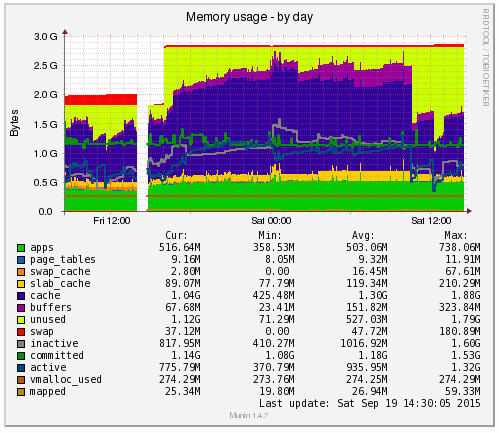
Likewise when looking at the memory usage via SSH;

This again echoes the Munin data. The above data is in kBs, showing around 1.3GB of free RAM opposed to 300MB previously.
Summary
What is extremely simple to achieve on your personal computer is a little more challenging to setup, implement and report on for your web server. Web server management is an extremely specialised field which is why we only use the best technology with a dedicated team of server engineers behind the scenes to ensure that we are continually improving the performance of our web servers. All of this is to work towards the constant goal of 100% up-time for your business websites.
Not all web hosting is the same and not all web hosting companies work in the same way. Speaking for ourselves, we take web hosting seriously. A web server is not just a computer that sits in the corner somewhere which hosts your website. A web server is the cornerstone of your digital storefront which is why we invest heavily by utilising leading technologies allowing us to continually improve our services for all our web hosting customers.
As a take away from this post. If you’re a non-technical person looking for web hosting, you can guarantee that we’re ‘on it’ when it comes to hosting. If you’re a technical person reading this, then the top tip is to use multiple web server resource monitoring packages to provide a full insight into performance as some tools aren’t as accurate as they may seem on first glance.
by Michael Cropper | Aug 29, 2015 | Developer |
You may recall a while ago how we covered how to migrate a web server seamlessly with zero downtime. This was great in that specific example as there were no ecommerce websites hosted on that specific web server. Things get a little more complex when with ecommerce websites for several reasons including;
- You won’t want customers placing orders on the website which is still hosted on your old web server as you may not actually pick this up and this would be a very bad experience for the customer and potentially lost revenue
- Your payment gateway technology may actually inform the website on your old server that a payment has been made, but not the website on your new web server due to the way the backbone of the internet works, the DNS.
- Any downtime during an ecommerce website migration between web servers is likely to result in a lot of lost revenue
You simply cannot afford any mistakes when working with an ecommerce website as any mistakes could result in a real mess. All of this is due to the way the Domain Name System, the DNS, works which we’ll go into in a little bit more detail.

In the previous example outlined in the other blog post referenced earlier, we simply updated the name servers and off we went. For ecommerce sites though, this is a problem. Updating the name servers at your registrar (the people you bought your domain name from) can take up to 24-48 hours to fully propagate the whole Domain Name System. Meaning that during this time, some website visitors would see the website that is hosted on your old web server and some customers would see the website that is hosted on your new web server. For many businesses, this is not a problem as the two sites would be identical anyway. For ecommerce websites though, this actively creates problems which then need to be cleaned up later which can be a nightmare. So we need a different approach here.
How to Migrate an Ecommerce Website between Servers with Zero Downtime
A note before we get started, this setup is not a definitive guide to the topic as every single setup is different so please check your own settings before jumping in with changing things unless you are fully sure what you are doing. Making changes with the settings below can result in a lot of problems if you don’t get things right. If you need any support with migrating your ecommerce website, then get in touch and we can help you with this process. . Anyhow, let’s just jump straight into how to do this and we’ll look at the explanations along the way;
- Identify the current DNS Authority: You need to be working with a system which gives you full control over the DNS management, so that you can add A Records to your DNS specifically. The DNS Management is currently sitting with whoever your name servers are pointing at. For example, our name servers, ns1.contradodigital.com and ns2.contradodigital.com mean that our DNS is being managed by contradodigital.com. If your name servers are set to your registrar then this is who the authority is for your DNS settings.
- Migrate your DNS Settings: Generally speaking, when you are migrating your ecommerce website you are also wanting to migrate your DNS management from your old supplier to your new supplier. Assuming this, then you’ll need to migrate your DNS settings first. Firstly you need to look at all of your current DNS settings that are in place and migrate all of these settings, except the name server settings, over to your new DNS Authority.
- Keep the A Record in the DNS Settings at your new DNS Authority the same for now: As part of the DNS settings migration you just did, you will have copied over an A Record which is specifically used to tell the Domain Name System what the IP address of the server is when someone types in http://example.com or http://www.example.com into their browser. For now, keep this record pointing at your old web server so that everything continues to work as normal.
- Sit back and wait 24 hours: As the Domain Name System can take a while to update all the records everywhere, just go and do something else for a while until you are confident that the systems have updated. Most systems are much faster than this, and we can actually customer the Time To Live (TTL) with our DNS Management which means we can specifically set the amount of time other computers should store certain information they have about the DNS settings before requesting the information again from the authoritative source. This comes in extremely useful later on which is why we can migrate an ecommerce website with zero downtime (almost).
- Update your Name Servers: The name servers at your registrar will currently be pointing to your old DNS Authority, likely the same company who managed your old web server. You need to update your name servers to point to the correct location for the company who is managing your DNS from now. For example, when companies are migrating their web hosting to us, this means that they would update their name servers to ns3.contradodigital.com and ns4.contradodigital.com.
- Sit back and wait 24 hours: As before, we now need to wait a while for the Domain Name System to update all of the data so that the new authority for the DNS management is your new company. During this time, as people visit http://www.example.com, some people will see the old name server settings, which means they will view the website on your old server, and some people will see the new name server settings, which means they will also view the website on your old server as we kept the A Record the same so that the website continues to work.
- Migrate the Website: This is very specific to each website, technology and other server settings that need to be migrated so we won’t touch on the topic a great deal here. Suffice to say that whatever technologies you are using, you need to copy across the files, databases, plugins, extensions, well basically everything. If you miss anything during this point you will be picking up the pieces afterwards. When migrating your database specifically, you may find that you need to do a bit of intermediate work to update the table names potentially based on how the old and new servers automatically generate the table names for any website technologies you are using so bear this in mind.
- Add a Holding Page on the Website: This is extremely important to do this during the migration to avoid any activities happening on the website on the old server as we would need to comb through the differences and manually migrate anything that happened during the time from migrating the website to updating the A Records later on. Depending on your technical setup, websites purpose and other factors, you may choose to do this before Step 7 which would mean the website would be offline for a short period of time but would mean that you don’t need to implement Step 9 below.
- Migrate the Database Again: For ecommerce websites, the majority of the activities are database driven from users, such as purchasing a product or commenting on a blog post. There is often very little files that are uploaded to the website which means that you should be OK to just migrate the database one last time. Your website may be different though, so if in doubt, get in touch and we can guide you through the process. It is essential that your holding page throws a 503 Error in the header or your Google website rankings will fall off a cliff, meaning your website traffic and revenue will follow and could take a few weeks to recover. Google’s guidelines on dealing with planned maintenance is useful to read over.
- Update the A Records to Point to the new Web Server: Now you have migrated the database again, the website on your new web server is ready to go live. So pop back into your DNS settings and update the A Record to point to the IP address of your new web server instead of your old web server. As mentioned earlier, you are better off if you can manage the Time To Live (TTL) settings directly so that you can speed up the time it takes for the new settings to spread throughout the Domain Name System.
- Deactivate the Holding Page: Your website on the new web server is ready to go, so let your customers come flooding back in!
The entire process above means that your website should be offline for no longer than 5-10 minutes (virtually Zero downtime!). If you get anything wrong within this process of you don’t have the ability to manage certain settings then this clearly may take longer, which is why we always recommend you use a reputable web hosting company and that you are working with the right digital agency who has the skills, knowledge and expertise to manage this effectively for you.
For Windows users, several of the steps above require changes to your hosts file so that you are sure you are looking at the right web server when making changes. Make sure you double check your hosts file settings throughout the entire process to make sure you are doing what you think you are doing on the right server as it could cause you problems if you do the wrong thing. Particularly if it is database related and you accidentally overwrite your database with a blank database. That would not be good.
Considerations during the Migration
Any business has many moving parts, all of which touch on the website in one way or another. For larger businesses you need to really plan the timelines involved with this process and communicate this with everyone in your organisation. The last thing you want to see is customers calling you about a problem and your staff not being able to access your website for further information or have no idea about what is going on;
- SEO: From an SEO point, you need to make sure your website is throwing a 503 Error in the header to avoid you losing your website rankings, traffic and sales during the migration. Getting this wrong can result in a situation taking a good few weeks to resolve itself. Google’s guidelines on dealing with planned downtime are useful to read over.
- PPC: Are you running any pay per click advertising campaigns currently that need to be paused during the migration? If Google AdWords picks up that they are seeing 503 Error messages on your website, they will start to flag problems within your Google AdWords account. So it’s always best to pause these if your planned downtime may not quite go according to plan. Alternatively for high volume websites you may decide to continue running AdWords campaigns to maximise revenue during the process and simply mop up and messages that have been flagged within your AdWords account afterwards.
- Email marketing campaigns: Communicating with your entire business means that you aren’t going to be sending out any email marketing campaigns during your planned website migration. Sending out an email marketing campaign resulting in hundreds of thousands of extra visitors trying to access the website only to find it is not available for those few minutes can damage your branding.
- Social media activities: As above, it’s best not to plan any significant social media campaign during this time which encourages customers to visit your website for the same reasons as outlined earlier.
- Offline activities: Are there any offline activities within your business that could be impacted by a short period of time with the website migration?
- Server settings: Are there any other server settings that you need to be aware of during the migration such as SSL certificates, redirects that have been implemented in a server control panel, email accounts or mail forwarders that have been set up on the server instead of on Microsoft Exchange? Double & triple check everything because in our experience, it is that one setting that everyone forgot about or never knew was implemented on the old server which causes the biggest problems.
Migrating an ecommerce website with (virtually) zero downtime requires a lot of planning, the right systems, technology and people in place to get things right. If you are in any doubt about migrating your ecommerce website then get in touch and we can guide you through the process.
by Michael Cropper | Aug 29, 2015 | SEO |
You may recall a while ago how we covered how to migrate a web server seamlessly with zero downtime. This was great in that specific example as there were no ecommerce websites hosted on that specific web server. Things get a little more complex when with ecommerce websites for several reasons including;
- You won’t want customers placing orders on the website which is still hosted on your old web server as you may not actually pick this up and this would be a very bad experience for the customer and potentially lost revenue
- Your payment gateway technology may actually inform the website on your old server that a payment has been made, but not the website on your new web server due to the way the backbone of the internet works, the DNS.
- Any downtime during an ecommerce website migration between web servers is likely to result in a lot of lost revenue
You simply cannot afford any mistakes when working with an ecommerce website as any mistakes could result in a real mess. All of this is due to the way the Domain Name System, the DNS, works which we’ll go into in a little bit more detail.

In the previous example outlined in the other blog post referenced earlier, we simply updated the name servers and off we went. For ecommerce sites though, this is a problem. Updating the name servers at your registrar (the people you bought your domain name from) can take up to 24-48 hours to fully propagate the whole Domain Name System. Meaning that during this time, some website visitors would see the website that is hosted on your old web server and some customers would see the website that is hosted on your new web server. For many businesses, this is not a problem as the two sites would be identical anyway. For ecommerce websites though, this actively creates problems which then need to be cleaned up later which can be a nightmare. So we need a different approach here.
How to Migrate an Ecommerce Website between Servers with Zero Downtime
A note before we get started, this setup is not a definitive guide to the topic as every single setup is different so please check your own settings before jumping in with changing things unless you are fully sure what you are doing. Making changes with the settings below can result in a lot of problems if you don’t get things right. If you need any support with migrating your ecommerce website, then get in touch and we can help you with this process. . Anyhow, let’s just jump straight into how to do this and we’ll look at the explanations along the way;
- Identify the current DNS Authority: You need to be working with a system which gives you full control over the DNS management, so that you can add A Records to your DNS specifically. The DNS Management is currently sitting with whoever your name servers are pointing at. For example, our name servers, ns1.contradodigital.com and ns2.contradodigital.com mean that our DNS is being managed by contradodigital.com. If your name servers are set to your registrar then this is who the authority is for your DNS settings.
- Migrate your DNS Settings: Generally speaking, when you are migrating your ecommerce website you are also wanting to migrate your DNS management from your old supplier to your new supplier. Assuming this, then you’ll need to migrate your DNS settings first. Firstly you need to look at all of your current DNS settings that are in place and migrate all of these settings, except the name server settings, over to your new DNS Authority.
- Keep the A Record in the DNS Settings at your new DNS Authority the same for now: As part of the DNS settings migration you just did, you will have copied over an A Record which is specifically used to tell the Domain Name System what the IP address of the server is when someone types in http://example.com or http://www.example.com into their browser. For now, keep this record pointing at your old web server so that everything continues to work as normal.
- Sit back and wait 24 hours: As the Domain Name System can take a while to update all the records everywhere, just go and do something else for a while until you are confident that the systems have updated. Most systems are much faster than this, and we can actually customer the Time To Live (TTL) with our DNS Management which means we can specifically set the amount of time other computers should store certain information they have about the DNS settings before requesting the information again from the authoritative source. This comes in extremely useful later on which is why we can migrate an ecommerce website with zero downtime (almost).
- Update your Name Servers: The name servers at your registrar will currently be pointing to your old DNS Authority, likely the same company who managed your old web server. You need to update your name servers to point to the correct location for the company who is managing your DNS from now. For example, when companies are migrating their web hosting to us, this means that they would update their name servers to ns3.contradodigital.com and ns4.contradodigital.com.
- Sit back and wait 24 hours: As before, we now need to wait a while for the Domain Name System to update all of the data so that the new authority for the DNS management is your new company. During this time, as people visit http://www.example.com, some people will see the old name server settings, which means they will view the website on your old server, and some people will see the new name server settings, which means they will also view the website on your old server as we kept the A Record the same so that the website continues to work.
- Migrate the Website: This is very specific to each website, technology and other server settings that need to be migrated so we won’t touch on the topic a great deal here. Suffice to say that whatever technologies you are using, you need to copy across the files, databases, plugins, extensions, well basically everything. If you miss anything during this point you will be picking up the pieces afterwards. When migrating your database specifically, you may find that you need to do a bit of intermediate work to update the table names potentially based on how the old and new servers automatically generate the table names for any website technologies you are using so bear this in mind.
- Add a Holding Page on the Website: This is extremely important to do this during the migration to avoid any activities happening on the website on the old server as we would need to comb through the differences and manually migrate anything that happened during the time from migrating the website to updating the A Records later on. Depending on your technical setup, websites purpose and other factors, you may choose to do this before Step 7 which would mean the website would be offline for a short period of time but would mean that you don’t need to implement Step 9 below.
- Migrate the Database Again: For ecommerce websites, the majority of the activities are database driven from users, such as purchasing a product or commenting on a blog post. There is often very little files that are uploaded to the website which means that you should be OK to just migrate the database one last time. Your website may be different though, so if in doubt, get in touch and we can guide you through the process. It is essential that your holding page throws a 503 Error in the header or your Google website rankings will fall off a cliff, meaning your website traffic and revenue will follow and could take a few weeks to recover. Google’s guidelines on dealing with planned maintenance is useful to read over.
- Update the A Records to Point to the new Web Server: Now you have migrated the database again, the website on your new web server is ready to go live. So pop back into your DNS settings and update the A Record to point to the IP address of your new web server instead of your old web server. As mentioned earlier, you are better off if you can manage the Time To Live (TTL) settings directly so that you can speed up the time it takes for the new settings to spread throughout the Domain Name System.
- Deactivate the Holding Page: Your website on the new web server is ready to go, so let your customers come flooding back in!
The entire process above means that your website should be offline for no longer than 5-10 minutes (virtually Zero downtime!). If you get anything wrong within this process of you don’t have the ability to manage certain settings then this clearly may take longer, which is why we always recommend you use a reputable web hosting company and that you are working with the right digital agency who has the skills, knowledge and expertise to manage this effectively for you.
For Windows users, several of the steps above require changes to your hosts file so that you are sure you are looking at the right web server when making changes. Make sure you double check your hosts file settings throughout the entire process to make sure you are doing what you think you are doing on the right server as it could cause you problems if you do the wrong thing. Particularly if it is database related and you accidentally overwrite your database with a blank database. That would not be good.
Considerations during the Migration
Any business has many moving parts, all of which touch on the website in one way or another. For larger businesses you need to really plan the timelines involved with this process and communicate this with everyone in your organisation. The last thing you want to see is customers calling you about a problem and your staff not being able to access your website for further information or have no idea about what is going on;
- SEO: From an SEO point, you need to make sure your website is throwing a 503 Error in the header to avoid you losing your website rankings, traffic and sales during the migration. Getting this wrong can result in a situation taking a good few weeks to resolve itself. Google’s guidelines on dealing with planned downtime are useful to read over.
- PPC: Are you running any pay per click advertising campaigns currently that need to be paused during the migration? If Google AdWords picks up that they are seeing 503 Error messages on your website, they will start to flag problems within your Google AdWords account. So it’s always best to pause these if your planned downtime may not quite go according to plan. Alternatively for high volume websites you may decide to continue running AdWords campaigns to maximise revenue during the process and simply mop up and messages that have been flagged within your AdWords account afterwards.
- Email marketing campaigns: Communicating with your entire business means that you aren’t going to be sending out any email marketing campaigns during your planned website migration. Sending out an email marketing campaign resulting in hundreds of thousands of extra visitors trying to access the website only to find it is not available for those few minutes can damage your branding.
- Social media activities: As above, it’s best not to plan any significant social media campaign during this time which encourages customers to visit your website for the same reasons as outlined earlier.
- Offline activities: Are there any offline activities within your business that could be impacted by a short period of time with the website migration?
- Server settings: Are there any other server settings that you need to be aware of during the migration such as SSL certificates, redirects that have been implemented in a server control panel, email accounts or mail forwarders that have been set up on the server instead of on Microsoft Exchange? Double & triple check everything because in our experience, it is that one setting that everyone forgot about or never knew was implemented on the old server which causes the biggest problems.
Migrating an ecommerce website with (virtually) zero downtime requires a lot of planning, the right systems, technology and people in place to get things right. If you are in any doubt about migrating your ecommerce website then get in touch and we can guide you through the process.
by Michael Cropper | Aug 29, 2015 | Digital Strategy |
You may think this is a strange title for a blog post, particularly when we are always talking about integrated online marketing and how it’s essential to join the dots within your organisation. Well this is true and we aren’t having a disagreement with ourselves here. What we’re talking about when it comes to decoupling your digital services is specifically technology related and how it is important to keep control of your systems and decrease dependencies.

Having a technical background myself, I naturally like to see technical aspects and website development design patters in real life. I’m a geek, get over it 🙂 But seriously, applying the same methodologies to your business can have significant benefits just as it can within the digital world of programming and website development.
In the Programming World
I’m not going to bore you with the finer details about the technical requirements behind website design and development, I’ll leave that for another blog post. Instead, and to keep things simple, let’s look at two options. Repeating yourself or referring to what you said.
Repeating yourself
Whatever you do in business you often end up repeating yourself quite a lot. Whether this is related to staff training, staff development, internal communications, describing processes, as part of the sales process and more. This is certainly one way to do things. But what if you didn’t have to keep repeating yourself. Let’s ignore the real world for a minute and how people like people and all that. Let’s just look at the task of saying the same thing over and over again. There must be a more efficient way of working.
Referring to what you said
So as an alternative. Imagine that every time someone asked you a question, you could simply point them in the direction of the answer. Saving you valuable time and money within your business. You would naturally get asked the same questions again and again over a period of time which can soon add up into significant time savings for your personal time and throughout your business as a whole. This is where systems, design patters and processes come into play.
Object Orientated Programming
The above example about referring to what you said is called Object Orientated Programming in the website development world. It basically means that you don’t have to keep repeating yourself when writing code. Instead you can simply refer to the piece of code you need and pull in this information as and when needed.
This is extremely important as this decouples your functionality within the code and makes it significantly easier to develop and maintain over time. And this is the lesson about how you can use the same design patterns within your business by decoupling your digital services.
Decoupling your Digital Services
Following on with this same example, imagine if your entire business was run from a single computer. This computer was used to handle customer enquiries, send invoices, do accounts, manage your website, handle your customer relationship management system and more. It would be quite a challenge for many people to use the same computer doing different tasks at the same time.
Now bringing this towards key digital services that you have, let’s look at a common setup for businesses within the SME bracket, they generally have;
- A domain name
- A web server
- Email technologies
- Website technologies
- Email marketing technologies
- Social media management tools
- Integrated systems
- Stock control systems
- Accountancy systems
- Project management systems
- And many more items
Looking at a few of these, picture this scenario (which we’ve seen happen on numerous occasions). All of the following services are purchased from a single provider which is either a software company, a digital agency or some specialist system;
- Your domain name
- Your web server
- Your email technologies live on the web server
- Your website is a custom built content management system
- Your email marketing campaigns are managed through your website
- Your social media updates are automatically posted based on the content of your website
- Your project management system lives on your web server
Now, what happens when your web server dies? An unbelievable amount of businesses do not have an automated backup solution in place for their web server which is shocking and highly risky. Taking this one step further, which again is based on what we’ve seen on numerous occasions, what if your web server was managed completely by a 3rd party such as your web designer. What then happens when they go AWOL? Quite simply, you’re screwed. And this is the importance of decoupling your digital services to protect your business and make your life much simpler.
How to decouple your digital services
Think strategically and plan for the worst case scenario. Firstly, it is absolutely essential that you own all of your digital assets. Once you’ve read over that, let’s look at how you actually go about decoupling your digital services. Before we do though, it’s important to say here that there are always trade-offs based on the skill set within your business and the skills you require from 3rd parties like ourselves. At Contrado Digital, we always work in a structured way to ensure the businesses we work with have complete ownership over their digital assets. We work in a way whereby we simply manage businesses digital assets on their behalf. It’s no good us owning your website, what good is this to us, really?
Starting from the top;
- A domain name: Make sure this is registered with an actual registrar. We could sell you a domain name if we wanted, but we choose not to. Just go direct to a registrar such as 123-Reg.co.uk or GoDaddy. Keeping this under your full control will make your life so much easier if you decide to switch providers for your website. Believe it or not, some companies will actually hold you to ransom by keeping your domain name if you decide to stop using their services. Reputable providers such as 123-Reg.co.uk and GoDaddy clearly don’t do this.
- A web server: Again, make sure this is suitable for your needs and is decoupled from your registrar. Many businesses when they first start buy a domain name they then buy the addon web hosting package available too. You really need to stop and think about this because if you are purchasing a web hosting package that is unsuitable (or doesn’t have automated backups in place) then you are going to run into problems sooner rather than later. Particularly when many web hosting packages will tie you in for a minimum of 12 months, this can be a costly decision to make.
- Email technologies: Many smaller businesses around the sub £500,000 turnover mark use email technologies that are sitting on their web server. Quite simply, stop doing this. Read over our Really Simple Guide to Business Email Addresses to understand why and just get Microsoft Exchange in place throughout your business. Again, decoupling your email technologies from your domain name and from your web server. It will save you a heap of time and effort in the long run.
- Website technologies: If you have purchased your domain name from one of the many website builder type companies around, you will likely have purchased a website builder package from them too. You don’t own this and this is an extremely risky strategy as you cannot simply take your website elsewhere, you are well and truly tied into their services for life unless you start everything from scratch and rebuild your website. Start thinking about decoupling your digital services at the start. And whenever you hear the words of a a company wanting to build you a bespoke website or bespoke content management system, run for the hills.
- Email marketing technologies: We’ve seen email marketing technologies run by many companies under a form of white label system, whereby it appears that the email marketing system is being provided by an individual company when in fact this is actually being run by a much larger company in the background. In our experience, many of the basic white label email marketing technologies aren’t that good, particularly when you compare them to the extremely affordable services from companies such as MailChimp. Not only do companies like MailChimp provide a better service based on their underlying technology, they are also another step to decouple your digital services from a single company.
- And many more items….you get the point
For any set of systems, if you are dependent on a single point of failure not failing then you increase the risk of running into problems at some point down the line. Start to decouple your digital services and think more strategically about what technologies you really need in place and how you can orchestrate your digital assets in a way that works for your business.
Integration
Before we finish the details about the importance of decoupling your digital services, we need to look seriously at integration. It is essential that systems integrate together. A decoupled system that stands in complete isolation is going to be even worse for you than a coupled system. Many older systems (as in +2 years old) don’t integrate that well on the whole. Technology moves on at such a pace that it is essential to keep up to date.
As a prime example, the accountancy system Xero which is taking the world by storm allows you to integrate your website ecommerce systems directly with your accountancy package to make your life easier managing your accounts. Whether this is you personally, an internal book keeper, an internal accounts team or an external accountancy practice. Integrating website technologies directly with your accountancy system will save your business a significant amount of time in the long run. Or, of course, you could carry on doing things the old way.
Systems that integrate well together are the systems that are going to be around for years to come. Systems that work in complete isolation are going to be replaced by better, smarter and faster systems that automate work, save your business money and allow you to focus on the things that matter.
Get in touch if you would like to discuss your digital systems, their suitability and how they are going to help or hinder your business growth.
by Michael Cropper | Aug 29, 2015 | SEO |
You may think this is a strange title for a blog post, particularly when we are always talking about integrated online marketing and how it’s essential to join the dots within your organisation. Well this is true and we aren’t having a disagreement with ourselves here. What we’re talking about when it comes to decoupling your digital services is specifically technology related and how it is important to keep control of your systems and decrease dependencies.

Having a technical background myself, I naturally like to see technical aspects and website development design patters in real life. I’m a geek, get over it 🙂 But seriously, applying the same methodologies to your business can have significant benefits just as it can within the digital world of programming and website development.
In the Programming World
I’m not going to bore you with the finer details about the technical requirements behind website design and development, I’ll leave that for another blog post. Instead, and to keep things simple, let’s look at two options. Repeating yourself or referring to what you said.
Repeating yourself
Whatever you do in business you often end up repeating yourself quite a lot. Whether this is related to staff training, staff development, internal communications, describing processes, as part of the sales process and more. This is certainly one way to do things. But what if you didn’t have to keep repeating yourself. Let’s ignore the real world for a minute and how people like people and all that. Let’s just look at the task of saying the same thing over and over again. There must be a more efficient way of working.
Referring to what you said
So as an alternative. Imagine that every time someone asked you a question, you could simply point them in the direction of the answer. Saving you valuable time and money within your business. Since you have invested you time and money, it is important to secure you data and resources with multi-factor authentication.You would naturally get asked the same questions again and again over a period of time which can soon add up into significant time savings for your personal time and throughout your business as a whole. This is where systems, design patters and processes come into play.
Object Orientated Programming
The above example about referring to what you said is called Object Orientated Programming in the website development world. It basically means that you don’t have to keep repeating yourself when writing code. Instead you can simply refer to the piece of code you need and pull in this information as and when needed.
This is extremely important as this decouples your functionality within the code and makes it significantly easier to develop and maintain over time. And this is the lesson about how you can use the same design patterns within your business by decoupling your digital services.
Decoupling your Digital Services
Following on with this same example, imagine if your entire business was run from a single computer. This computer was used to handle customer enquiries, send invoices, do accounts, manage your website, handle your customer relationship management system and more. It would be quite a challenge for many people to use the same computer doing different tasks at the same time.
Now bringing this towards key digital services that you have, let’s look at a common setup for businesses within the SME bracket, they generally have;
- A domain name
- A web server
- Email technologies
- Website technologies
- Email marketing technologies
- Social media management tools
- Integrated systems
- Stock control systems
- Accountancy systems
- Project management systems
- And many more items
Looking at a few of these, picture this scenario (which we’ve seen happen on numerous occasions). All of the following services are purchased from a single provider which is either a software company, a digital agency or some specialist system;
- Your domain name
- Your web server
- Your email technologies live on the web server
- Your website is a custom built content management system
- Your email marketing campaigns are managed through your website
- Your social media updates are automatically posted based on the content of your website
- Your project management system lives on your web server
Now, what happens when your web server dies? An unbelievable amount of businesses do not have an automated backup solution in place for their web server which is shocking and highly risky. Taking this one step further, which again is based on what we’ve seen on numerous occasions, what if your web server was managed completely by a 3rd party such as your web designer. What then happens when they go AWOL? Quite simply, you’re screwed. And this is the importance of decoupling your digital services to protect your business and make your life much simpler.
How to decouple your digital services
Think strategically and plan for the worst case scenario. Firstly, it is absolutely essential that you own all of your digital assets. Once you’ve read over that, let’s look at how you actually go about decoupling your digital services. Before we do though, it’s important to say here that there are always trade-offs based on the skill set within your business and the skills you require from 3rd parties like ourselves. At Contrado Digital, we always work in a structured way to ensure the businesses we work with have complete ownership over their digital assets. We work in a way whereby we simply manage businesses digital assets on their behalf. It’s no good us owning your website, what good is this to us, really?
Starting from the top;
- A domain name: Make sure this is registered with an actual registrar. We could sell you a domain name if we wanted, but we choose not to. Just go direct to a registrar such as 123-Reg.co.uk or GoDaddy. Keeping this under your full control will make your life so much easier if you decide to switch providers for your website. Believe it or not, some companies will actually hold you to ransom by keeping your domain name if you decide to stop using their services. Reputable providers such as 123-Reg.co.uk and GoDaddy clearly don’t do this.
- A web server: Again, make sure this is suitable for your needs and is decoupled from your registrar. Many businesses when they first start buy a domain name they then buy the addon web hosting package available too. You really need to stop and think about this because if you are purchasing a web hosting package that is unsuitable (or doesn’t have automated backups in place) then you are going to run into problems sooner rather than later. Particularly when many web hosting packages will tie you in for a minimum of 12 months, this can be a costly decision to make.
- Email technologies: Many smaller businesses around the sub £500,000 turnover mark use email technologies that are sitting on their web server. Quite simply, stop doing this. Read over our Really Simple Guide to Business Email Addresses to understand why and just get Microsoft Exchange in place throughout your business. Again, decoupling your email technologies from your domain name and from your web server. It will save you a heap of time and effort in the long run.
- Website technologies: If you have purchased your domain name from one of the many website builder type companies around, you will likely have purchased a website builder package from them too. You don’t own this and this is an extremely risky strategy as you cannot simply take your website elsewhere, you are well and truly tied into their services for life unless you start everything from scratch and rebuild your website. Start thinking about decoupling your digital services at the start. And whenever you hear the words of a a company wanting to build you a bespoke website or bespoke content management system, run for the hills.
- Email marketing technologies: We’ve seen email marketing technologies run by many companies under a form of white label system, whereby it appears that the email marketing system is being provided by an individual company when in fact this is actually being run by a much larger company in the background. In our experience, many of the basic white label email marketing technologies aren’t that good, particularly when you compare them to the extremely affordable services from companies such as MailChimp. Not only do companies like MailChimp provide a better service based on their underlying technology, they are also another step to decouple your digital services from a single company.
- And many more items….you get the point
For any set of systems, if you are dependent on a single point of failure not failing then you increase the risk of running into problems at some point down the line. Start to decouple your digital services and think more strategically about what technologies you really need in place and how you can orchestrate your digital assets in a way that works for your business.
Integration
Before we finish the details about the importance of decoupling your digital services, we need to look seriously at integration. It is essential that systems integrate together. A decoupled system that stands in complete isolation is going to be even worse for you than a coupled system. Many older systems (as in +2 years old) don’t integrate that well on the whole. Technology moves on at such a pace that it is essential to keep up to date.
As a prime example, the accountancy system Xero which is taking the world by storm allows you to integrate your website ecommerce systems directly with your accountancy package to make your life easier managing your accounts. Whether this is you personally, an internal book keeper, an internal accounts team or an external accountancy practice. Integrating website technologies directly with your accountancy system will save your business a significant amount of time in the long run. Or, of course, you could carry on doing things the old way.
Systems that integrate well together are the systems that are going to be around for years to come. Systems that work in complete isolation are going to be replaced by better, smarter and faster systems that automate work, save your business money and allow you to focus on the things that matter.
Get in touch if you would like to discuss your digital systems, their suitability and how they are going to help or hinder your business growth.
by Michael Cropper | Aug 18, 2015 | A Short Story About |
Today I wanted to share a short story about the importance of keeping your technology up to date within your business and the consequences if you heed to take notice of this advice. Far too often within business, business owners and employees have an approach of “do it once and forget about it”, well with technology, this approach is doomed to failure and can cost your business a lot of money in the long run.
Computer Hardware
The first recent example relates to a business whose computer equipment wasn’t as up to date as it should have been. The hardware was around 3 years old, which on a laptop by this time the performance has already started to significantly degrade from when you first bought it, and the software simply hadn’t been managed well during this time either.

While this is a recent example, this same scenario we have seen multiple times before with businesses of varying sizes so this is certainly not uncommon which is why we want to stress the importance of keeping your technology up to date. Avoid going through the same frustrations others businesses go through by implementing a common sense approach to maintaining your technology on a regular basis.
Firstly, running your business on slow computer hardware can significantly impact the performance of you, your staff and your business as a whole. For example, I recently heard a story from a reputable source which went as follows; UPS would save $1,000,000 of costs for every 60 seconds per day of time saved for each of their delivery drivers globally. When you start to add this up over the year, this is an enormous amount. Knowing this, they spend a significant amount of time, money and resources in optimising delivery routes using technology which is ultimately designed to work towards reducing the time it takes drivers to deliver parcels. Based on this, they implemented several interesting technologies designed to reduce wasted time. They placed a Bluetooth fob on each driver and connected all devices to the cloud. What this meant is that when the delivery driver had stopped at the next delivery point, known based on the GPS location, and they turned the engine off, the rear hatch of the van would open automatically, saving precious seconds of wasted time. As the driver walked up the garden path to deliver the parcel, if the package had not been signed for on their handheld device, this was a signal that the back of the van needed to be opened again automatically as the driver returns to the vehicle so the package can be placed back into the van, again saving precious seconds. Then finally, as the driver returned to the front of the vehicle, the engine would automatically start to save a further few seconds. Based on all of these small time savings throughout the day, UPS found that they would save 17 seconds per driver per day by utilising technology to drive efficiencies within the business. Based on the savings they make per 60 seconds, it is clear to see how this significantly impacts the bottom line. Whether this story is 100% accurate or not isn’t the point, this is a believable story about a company of this size. Regardless of the accuracy of this particular story the point is still valid about companies utilising technology to improve the business as a whole which is true in endless organisations.
Now I’m not saying that your business is going to go to these lengths to optimise your business but when you look at the computer hardware running in your business and ask yourself, is it helping or hindering your business and employees? Remember, there is no middle ground. A slow running computer results in staff sat there waiting for technology to keep up with them which is extremely inefficient and can cost a significant amount of money over time;
- 60 seconds per hour wasted
- 8 minutes per day
- 40 minutes per week
- 2.6 hours per month
- 34.6 hours per year
- X the number of employees
What is a week of time worth to you, your employees and your business as a whole? I can bet that it is more than the cost of upgrading the underperforming technology within your business!
Now this isn’t just about cost savings, but imagine what you could achieve in a week. Having an additional 2% of time available per year per employee, I’m sure you could achieve some amazing things. New customers, new processes, technologies, investments within your business, additional revenue and more.
The same is true for website technology. There have been countless studies proving how website speed directly impacts the performance of your website, particularly ecommerce and can show significant improvements in conversion rates and revenue based on technology improvements.
Skimping on your hardware is only costing your business money, just in ways that aren’t as clear to see. You either choose to do something about this and get the right technology in place that you need, or you choose to “put up with it for another year” and cost your business money.
Computer Software
Along the same lines as computer hardware, it is imperative to keep your computer software up to date. This is the software that you are using on a day-in-day-out basis which is powering your business. We’ve seen organisations still using Windows XP which is no longer supported from a security point and businesses running 5 year old software because they haven’t made the small investments of generally less than £200 to upgrade their software.

To put this into perspective, the same situation occurred with two businesses recently who were running outdated software on the computer. When it came to upgrading a completely separate system, their business email addresses, then integrating this into their current desktop software of their choice, the result was nothing but problems with their computer software.
What should have been a 2 minute job to integrate the two together turned out to be hours worth of work from both parties testing various solutions to fix the desktop software to work as it should do. Again, hours of wasted time for all involved because the wrong technology was implemented from the start, configured by someone who had no idea what they were doing and working form software that is now almost 6 years out of date.
Within business the decisions are simple, you either do the right thing, or you choose not to do the right thing. We see time and time again the cost of bad decisions when it comes to technology which is why we try and educate businesses to working with the right technology from the start to save them money.
We aren’t an IT support company, there are plenty of great IT support companies around who do that far better than we ever could. That being said, as we are in the technology industry working with leading edge technologies, we come across a lot of antiquated systems before we get around to upgrading them which often requires us to cross that bridge into the IT support world to integrate systems together.
Website Technology
Again, along the same lines as the several examples already given but now looking at website technology. A story about a businesses who required serious security updates to their WordPress website. On first glance, this sounded like an hour or two’s worth of work which was explained with the caveat that we would need to take a look at the underlying technology in a little more detail before we could provide an accurate estimate of the work involved.

Lo and behold, the same bad decisions in a different area we see time and time again. This time, the decision around 3 years ago was to purchase a cheap WordPress Theme from one of the many Theme Directories / Marketplaces on the web. This was likely an innocent decision to purchase a $49 theme “because it looked nice”. The realities of this meant that it was not possible to upgrade their system in the expected hour or two’s worth of work. Instead, this was looking like 4-5 day’s worth of time to implement the right solution and patch the security holes.
I won’t bore you with the finer technical details of this, so suffice to say that the problem lied with purchasing a poorly built WordPress Theme 3 years ago. Due to this, certain key ecommerce technologies and core WordPress files once upgraded would actively break the website, essentially closing the digital doors of your business and turning off your revenue stream. So it was either leave the website open to hackers by not patching known and commonly exploited security holes, or, making the essential upgrade to the right solution.
All of this can be avoided when you are working with the right digital agency and you select the suppliers who are adding value to your business. I’d urge you to consider the longer term impacts of the technology decisions you are making today. Time and time again we see bad decisions made with businesses having to spend a lot of money fixing problems instead of implementing real solutions to grow their business. For us, this is part and part of what we do, what we enjoy and ultimately what we get paid for. We would much rather be focusing work towards implementing technologies within your business that are going to take your business to the next level rather than fixing problems caused by poor decisions years ago. We do both thankfully and I can honestly say that the clients who see the greatest returns from their investment in digital and technology are the clients who make the right technology decisions time and time again. I’ll never forget a phrase an old colleague once said to me and it couldn’t be truer in this scenario, “Quick wins lead to long losses”. Think about that.
Solution
Ok, so we’ve talked about the problems that poor technology causes and given a few prime examples related to this. So what next? How do you keep your technology up to date without spending an arm and a leg every month? Well, it’s actually relatively straight forward and only requires a strict procedure within your business or from your suppliers who actively maintain the core aspects of your business;
- Hardware Technology: Keep it up to date! Slow hardware costs money in terms of staff time, unproductive time, missed opportunities and more. Invest in the right equipment to do the job. You could eat soup with a fork, but it’s probably best you use a spoon…
- Software Technology: Keep it up to date! Patch software and update as soon as possible after the improvement has been announced. Don’t delay and don’t wait years before upgrading. Out of date software causes a lot of problems and makes any integrations harder to work with. There is only so much you can do with the digital equivalent of Gaffer tape…
- Website Technology: Keep it up to date! Particularly when using popular open source software and 3rd party plugins, it is imperative to keep your website up to date purely from a security point of view to update core files, plugins and themes. Beyond this, regular website maintenance packages and continual improvements allows your website to be ever evolving and working for your business. So rather than seeing your website as a cost look at this as a digital asset worthy of investing in.
You may be noticing a trend here….keep your technology up to date or it will cost your business money further down the line. If you would like an informal conversation about how we can work together to keep your technology up to date then get in touch. Our focus is on digital marketing, online technologies and software integrations so if you need any IT support then if you don’t know of anyone who does this just drop us an email and we’ll be sure to point you in the right direction of a few great companies. If you’re looking for a sounding board for your technology decisions within your business we are more than happy to talk and have starter packages designed to give your business the expertise it needs to grow through our Digital Lifeline packages.
by Michael Cropper | Aug 18, 2015 | SEO |
Today I wanted to share a short story about the importance of keeping your technology up to date within your business and the consequences if you heed to take notice of this advice. Far too often within business, business owners and employees have an approach of “do it once and forget about it”, well with technology, this approach is doomed to failure and can cost your business a lot of money in the long run.
Computer Hardware
The first recent example relates to a business whose computer equipment wasn’t as up to date as it should have been. The hardware was around 3 years old, which on a laptop by this time the performance has already started to significantly degrade from when you first bought it, and the software simply hadn’t been managed well during this time either.

While this is a recent example, this same scenario we have seen multiple times before with businesses of varying sizes so this is certainly not uncommon which is why we want to stress the importance of keeping your technology up to date. Avoid going through the same frustrations others businesses go through by implementing a common sense approach to maintaining your technology on a regular basis.
Firstly, running your business on slow computer hardware can significantly impact the performance of you, your staff and your business as a whole. For example, I recently heard a story from a reputable source which went as follows; UPS would save $1,000,000 of costs for every 60 seconds per day of time saved for each of their delivery drivers globally. When you start to add this up over the year, this is an enormous amount. Knowing this, they spend a significant amount of time, money and resources in optimising delivery routes using technology which is ultimately designed to work towards reducing the time it takes drivers to deliver parcels. Based on this, they implemented several interesting technologies designed to reduce wasted time. They placed a Bluetooth fob on each driver and connected all devices to the cloud. What this meant is that when the delivery driver had stopped at the next delivery point, known based on the GPS location, and they turned the engine off, the rear hatch of the van would open automatically, saving precious seconds of wasted time. As the driver walked up the garden path to deliver the parcel, if the package had not been signed for on their handheld device, this was a signal that the back of the van needed to be opened again automatically as the driver returns to the vehicle so the package can be placed back into the van, again saving precious seconds. Then finally, as the driver returned to the front of the vehicle, the engine would automatically start to save a further few seconds. Based on all of these small time savings throughout the day, UPS found that they would save 17 seconds per driver per day by utilising technology to drive efficiencies within the business. Based on the savings they make per 60 seconds, it is clear to see how this significantly impacts the bottom line. Whether this story is 100% accurate or not isn’t the point, this is a believable story about a company of this size. Regardless of the accuracy of this particular story the point is still valid about companies utilising technology to improve the business as a whole which is true in endless organisations.
Now I’m not saying that your business is going to go to these lengths to optimise your business but when you look at the computer hardware running in your business and ask yourself, is it helping or hindering your business and employees? Remember, there is no middle ground. A slow running computer results in staff sat there waiting for technology to keep up with them which is extremely inefficient and can cost a significant amount of money over time;
- 60 seconds per hour wasted
- 8 minutes per day
- 40 minutes per week
- 2.6 hours per month
- 34.6 hours per year
- X the number of employees
What is a week of time worth to you, your employees and your business as a whole? I can bet that it is more than the cost of upgrading the underperforming technology within your business!
Now this isn’t just about cost savings, but imagine what you could achieve in a week. Having an additional 2% of time available per year per employee, I’m sure you could achieve some amazing things. New customers, new processes, technologies, investments within your business, additional revenue and more.
The same is true for website technology. There have been countless studies proving how website speed directly impacts the performance of your website, particularly ecommerce and can show significant improvements in conversion rates and revenue based on technology improvements.
Skimping on your hardware is only costing your business money, just in ways that aren’t as clear to see. You either choose to do something about this and get the right technology in place that you need, or you choose to “put up with it for another year” and cost your business money.
Computer Software
Along the same lines as computer hardware, it is imperative to keep your computer software up to date. This is the software that you are using on a day-in-day-out basis which is powering your business. We’ve seen organisations still using Windows XP which is no longer supported from a security point and businesses running 5 year old software because they haven’t made the small investments of generally less than £200 to upgrade their software.

To put this into perspective, the same situation occurred with two businesses recently who were running outdated software on the computer. When it came to upgrading a completely separate system, their business email addresses, then integrating this into their current desktop software of their choice, the result was nothing but problems with their computer software.
What should have been a 2 minute job to integrate the two together turned out to be hours worth of work from both parties testing various solutions to fix the desktop software to work as it should do. Again, hours of wasted time for all involved because the wrong technology was implemented from the start, configured by someone who had no idea what they were doing and working form software that is now almost 6 years out of date.
Within business the decisions are simple, you either do the right thing, or you choose not to do the right thing. We see time and time again the cost of bad decisions when it comes to technology which is why we try and educate businesses to working with the right technology from the start to save them money.
We aren’t an IT support company, there are plenty of great IT support companies around who do that far better than we ever could. That being said, as we are in the technology industry working with leading edge technologies, we come across a lot of antiquated systems before we get around to upgrading them which often requires us to cross that bridge into the IT support world to integrate systems together.
Website Technology
Again, along the same lines as the several examples already given but now looking at website technology. A story about a businesses who required serious security updates to their WordPress website. On first glance, this sounded like an hour or two’s worth of work which was explained with the caveat that we would need to take a look at the underlying technology in a little more detail before we could provide an accurate estimate of the work involved.

Lo and behold, the same bad decisions in a different area we see time and time again. This time, the decision around 3 years ago was to purchase a cheap WordPress Theme from one of the many Theme Directories / Marketplaces on the web. This was likely an innocent decision to purchase a $49 theme “because it looked nice”. The realities of this meant that it was not possible to upgrade their system in the expected hour or two’s worth of work. Instead, this was looking like 4-5 day’s worth of time to implement the right solution and patch the security holes.
I won’t bore you with the finer technical details of this, so suffice to say that the problem lied with purchasing a poorly built WordPress Theme 3 years ago. Due to this, certain key ecommerce technologies and core WordPress files once upgraded would actively break the website, essentially closing the digital doors of your business and turning off your revenue stream. So it was either leave the website open to hackers by not patching known and commonly exploited security holes, or, making the essential upgrade to the right solution.
All of this can be avoided when you are working with the right digital agency and you select the suppliers who are adding value to your business. I’d urge you to consider the longer term impacts of the technology decisions you are making today. Time and time again we see bad decisions made with businesses having to spend a lot of money fixing problems instead of implementing real solutions to grow their business. For us, this is part and part of what we do, what we enjoy and ultimately what we get paid for. We would much rather be focusing work towards implementing technologies within your business that are going to take your business to the next level rather than fixing problems caused by poor decisions years ago. We do both thankfully and I can honestly say that the clients who see the greatest returns from their investment in digital and technology are the clients who make the right technology decisions time and time again. I’ll never forget a phrase an old colleague once said to me and it couldn’t be truer in this scenario, “Quick wins lead to long losses”. Think about that.
Solution
Ok, so we’ve talked about the problems that poor technology causes and given a few prime examples related to this. So what next? How do you keep your technology up to date without spending an arm and a leg every month? Well, it’s actually relatively straight forward and only requires a strict procedure within your business or from your suppliers who actively maintain the core aspects of your business;
- Hardware Technology: Keep it up to date! Slow hardware costs money in terms of staff time, unproductive time, missed opportunities and more. Invest in the right equipment to do the job. You could eat soup with a fork, but it’s probably best you use a spoon…
- Software Technology: Keep it up to date! Patch software and update as soon as possible after the improvement has been announced. Don’t delay and don’t wait years before upgrading. Out of date software causes a lot of problems and makes any integrations harder to work with. There is only so much you can do with the digital equivalent of Gaffer tape…
- Website Technology: Keep it up to date! Particularly when using popular open source software and 3rd party plugins, it is imperative to keep your website up to date purely from a security point of view to update core files, plugins and themes. Beyond this, regular website maintenance packages and continual improvements allows your website to be ever evolving and working for your business. So rather than seeing your website as a cost look at this as a digital asset worthy of investing in.
You may be noticing a trend here….keep your technology up to date or it will cost your business money further down the line. If you would like an informal conversation about how we can work together to keep your technology up to date then get in touch. Our focus is on digital marketing, online technologies and software integrations so if you need any IT support then if you don’t know of anyone who does this just drop us an email and we’ll be sure to point you in the right direction of a few great companies. If you’re looking for a sounding board for your technology decisions within your business we are more than happy to talk and have starter packages designed to give your business the expertise it needs to grow through our Digital Lifeline packages.
by Michael Cropper | Aug 14, 2015 | Thoughts |
Today I want you to have a think about your organisation and its suppliers in general, digital or otherwise. And ask yourself the question; are your suppliers costing you money or adding value to your business?
Naturally with speaking with a lot of businesses we hear a lot of information and comments about costs, investments, pricing information and a lot of other information that enables us to get a good feel for how a business perceives different items within their business and supply chain. There is an excellent book titled The Slight Edge by Jeff Olson, which if you haven’t read I’d urge you to go out and buy a copy now. The book can really be summarised by the image below;
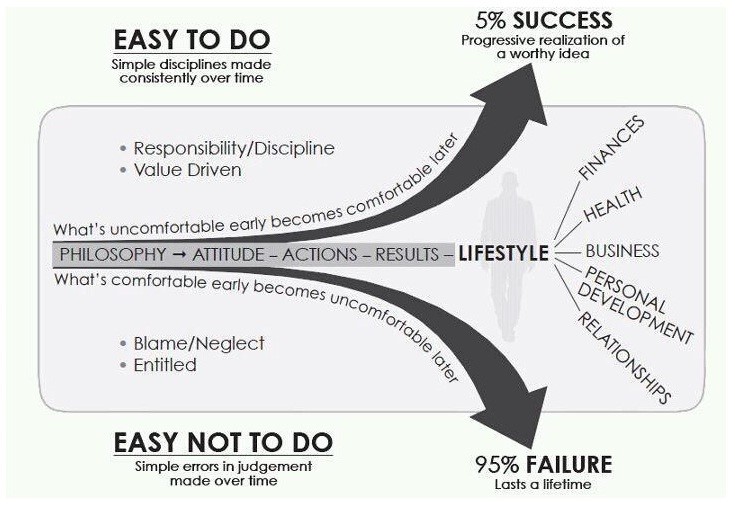
Source: http://slightedgecommunity.com/blogs/12726/3614/beyond-the-12-steps-the-slight
And summarised further by a quote from Yoda in Star Wars;
“No. Try not. Do… or do not. There is no try.” – Yoda
The same is true in business. You either make the right decision, or the wrong decision, there is no middle ground. Many businesses often make the wrong decisions when it comes to their digital assets, but we’ve already talked about that quite a bit recently. Here I want you to take a bit of time and think about your business in a slightly different way than you do currently. Think critically about where you are now, where you want to get to and if the decisions that are being made are working towards these goals or away from them. As Yoda said, there is no try, you are either making strategic decisions daily which are working towards your goals or you are naturally moving away from your goals either by doing nothing or making the wrong decisions.
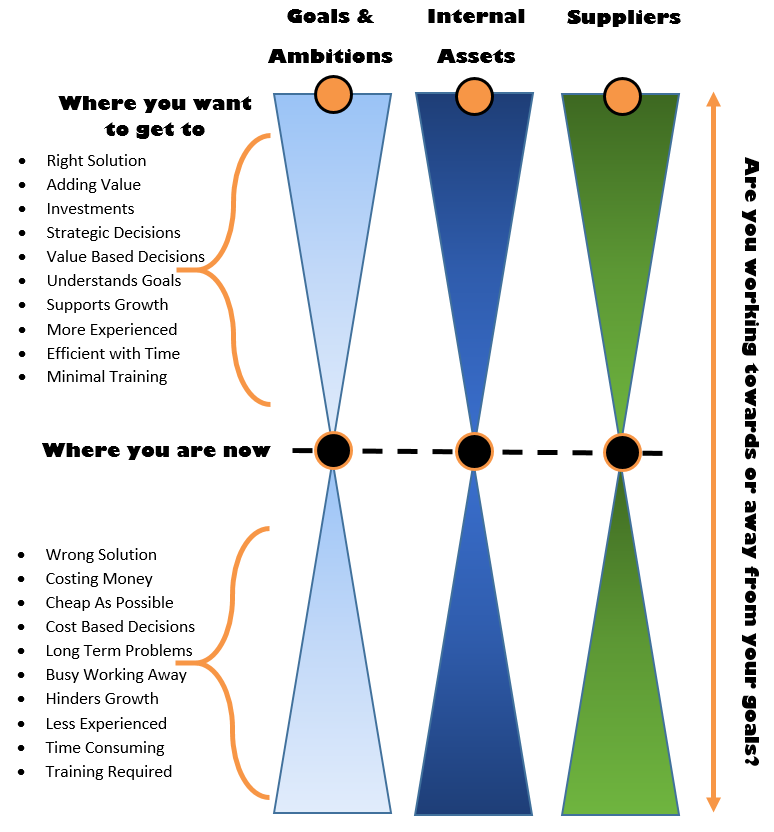
Markets are changing at a faster pace than ever before and as a business it is essential that you keep up to date with these changes to compete. There is an enormous cost of doing nothing within business as competitors are continually improving and markets are ever shifting. We’re not talking about significant innovation within your business, although this is absolutely essential and a topic for a future blog post, no, where talking about incremental improvements based on making strategic decisions that are going to move your business forward.
To put this into perspective, below are a few graphs showing the cost of doing nothing compared to the results of making the right decisions. The top graphs show a 5% decline year on year based on an ever more competitive market place, which you have failed to keep up with, and the bottom graph showing a 5% increase year on year based on making the right strategic decisions. The data is clear;
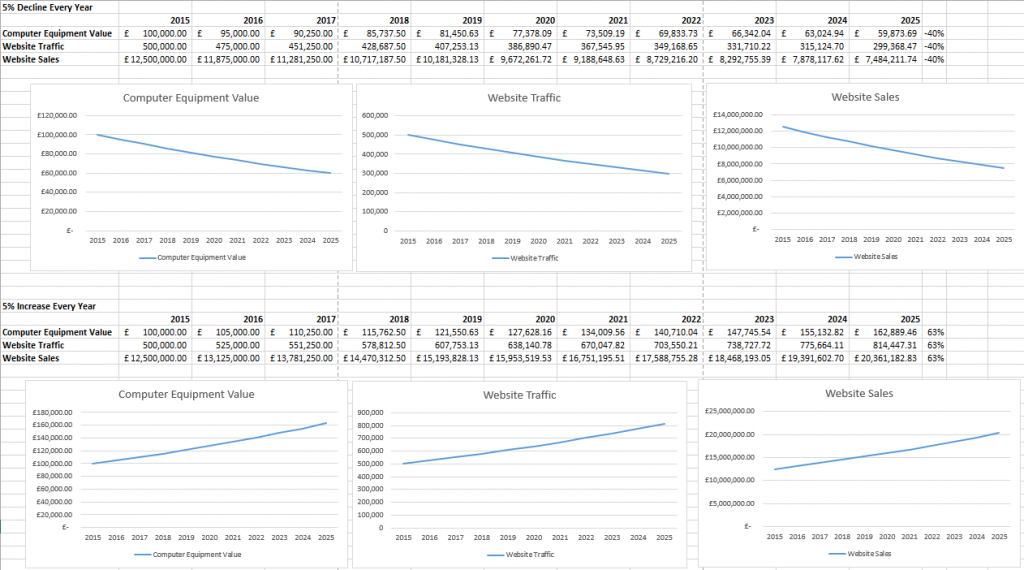
(click for larger graphs)
Remember, you are either actively improving your business in all aspects or you are falling behind. There is no middle ground of staying steady. Take some time and have a think about your business in a critical way for every aspect. And remember, we always have time for a coffee if you want to bounce a few ideas off us, we’re a friendly bunch and will always give you honest feedback and comments about your digital and technology choices whether this is what you want to hear or not. We like to work with businesses and help them along their journey to their goals and ambitions.
by Michael Cropper | Aug 14, 2015 | SEO |
Today I want you to have a think about your organisation and its suppliers in general, digital or otherwise. And ask yourself the question; are your suppliers costing you money or adding value to your business?
Naturally with speaking with a lot of businesses we hear a lot of information and comments about costs, investments, pricing information and a lot of other information that enables us to get a good feel for how a business perceives different items within their business and supply chain. There is an excellent book titled The Slight Edge by Jeff Olson, which if you haven’t read I’d urge you to go out and buy a copy now. The book can really be summarised by the image below;

Source: http://slightedgecommunity.com/blogs/12726/3614/beyond-the-12-steps-the-slight
And summarised further by a quote from Yoda in Star Wars;
“No. Try not. Do… or do not. There is no try.” – Yoda
The same is true in business. You either make the right decision, or the wrong decision, there is no middle ground. Many businesses often make the wrong decisions when it comes to their digital assets, but we’ve already talked about that quite a bit recently. Here I want you to take a bit of time and think about your business in a slightly different way than you do currently. Think critically about where you are now, where you want to get to and if the decisions that are being made are working towards these goals or away from them. As Yoda said, there is no try, you are either making strategic decisions daily which are working towards your goals or you are naturally moving away from your goals either by doing nothing or making the wrong decisions.

Markets are changing at a faster pace than ever before and as a business it is essential that you keep up to date with these changes to compete. There is an enormous cost of doing nothing within business as competitors are continually improving and markets are ever shifting. We’re not talking about significant innovation within your business, although this is absolutely essential and a topic for a future blog post, no, where talking about incremental improvements based on making strategic decisions that are going to move your business forward.
To put this into perspective, below are a few graphs showing the cost of doing nothing compared to the results of making the right decisions. The top graphs show a 5% decline year on year based on an ever more competitive market place, which you have failed to keep up with, and the bottom graph showing a 5% increase year on year based on making the right strategic decisions. The data is clear;

(click for larger graphs)
Remember, you are either actively improving your business in all aspects or you are falling behind. There is no middle ground of staying steady. Take some time and have a think about your business in a critical way for every aspect. And remember, we always have time for a coffee if you want to bounce a few ideas off us, we’re a friendly bunch and will always give you honest feedback and comments about your digital and technology choices whether this is what you want to hear or not. We like to work with businesses and help them along their journey to their goals and ambitions.
by Michael Cropper | Jul 1, 2015 | Digital Marketing, Thoughts, Tracking |
Why is it that so many businesses still see a website as a cost rather than an investment to generate a return? We live in a digital world so why isn’t your online presence at the forefront of your business strategy to increase revenue? Well, after speaking with thousands of businesses ranging from startups all the way up to companies with offices around the globe, I’ve noticed a few common comments and it’s time to debunk some of the common reasons we hear and get serious about your investments in digital channels.
The Current Situation
So many established businesses will happily spend money on traditional activities because that is what they have always done. The world has changed, it’s time to keep up or give up. Traditional ways that money is spent includes sponsoring awards, radio advertising, printed materials such as flyers and handouts, promotional products such as pads, pens and mugs, trade fairs, direct mail, advertisements in magazines and newspapers, printed banners, popup stands and many more methods. Money is spent in these areas without batting an eyelid. Because apparently this is what we need to run a business, right? Have you ever attempted to calculate the return you generated as a direct result of your spend on these activities? I imagine that if you have, you have also struggled to attribute any of these activities individually to a direct increase in revenue.
Let’s be clear here though, I’m not saying don’t do any of these. I’m a huge believer of testing everything and tracking the results. And yes, these activities certainly support your overall marketing strategy. But you have to ask yourself the question, if we live in a digital world, why aren’t you investing more seriously in digital channels? What are you afraid of?

If you see your website as a cost, you’ve already lost. A website should support your business goals, sales and marketing strategy and more. Your website should be a key touchpoint during the sales process or should be directly generating revenue for your business through ecommerce sales or generating enquiries.
Digital Doesn’t Work for Our Industry
Seriously? Did I just hear you correctly? I kid you not, this is something we have heard on multiple occasions.
** Takes a deep breath **
You think that digital doesn’t work in your industry? I ask you to prove to me that digital doesn’t work in your industry. I want to see all of the following that you have invested in previously and generated zero results if you truly believe that digital doesn’t work in your industry;
- Show me your Google Analytics data, how many visits are you getting per month from different traffic sources, what are these website visitors doing when they get to your website (Are they bouncing away straight away? It’s probably because you have a horrible website or you are getting low quality traffic), how many enquiries or sales are you generating through your website? (You aren’t tracking this you say?), is your website traffic increasing or decreasing every month? (You are tracking this on a regular basis aren’t you?)
- Show me how visible you are on Google when customers are searching for your key products and services? (You are tracking this data aren’t you?)
- Show me how your pay per click advertising campaigns are performing on Google AdWords (You have tested this haven’t you?)
- Show me how your social media campaigns are feeding into your digital marketing strategy to connect with key influencers and boost your brand online (You are active on social media on a regular basis aren’t you?)
- Show me how well your email marketing campaigns are performing, I want to see open rates, click through rates, popular content, active customers
- Show me your average order values and customer lifetime values per traffic source, I want to see how your individual digital marketing campaigns are performing against your traditional marketing activities. Show me the return on your investments for all of your activities.
During our initial analysis when speaking with businesses, we ask some very probing questions about the businesses we may choose to work with in the future. We want to make sure that you are ready to invest in digital seriously. We want to make sure that you are truly open to increasing your revenue through digital marketing, or whether you are simply looking at digital to dip your toe in and seeing everything as a cost and a tick box exercise.

Generally speaking, when we hear comments such as “Digital doesn’t work for our industry” there isn’t a great deal we can do to help at this stage. Let’s chat again in a couple of years when you’re ready to talk things through seriously and are more aware about how the world has changed. For those who can answer some of the basic questions outlined above, then this is where we come in to get you on the right track and get your digital marketing campaigns performing well.
We Had SEO Done Once
Search Engine Optimisation is never done. It is part of an ongoing process designed to increase organic traffic to your website over time and ultimately sales / enquiries / revenue depending on the sector you are working in. We’ve seen businesses who thought they “had SEO done” previously and decided to go no further, against our best efforts to convince them otherwise. Avoid making the same mistakes as we have seen to many other businesses make, invest in your digital channels to build long term results, rather than seeing SEO as “done”;
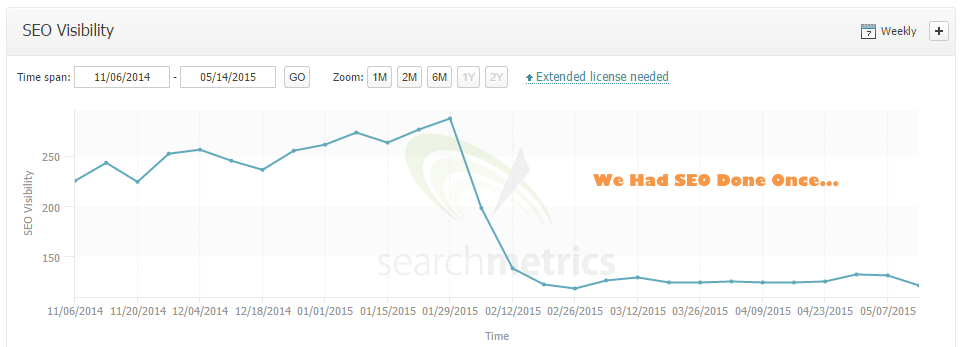
Would you ever see your physical shop or office space as being “done”? Or would you empty the bins daily, clean the carpets, tidy the desks, bring in new customers, promote your shop as being open, walk your shop floor daily, add new products to your inventory, run special offers and promotions to generate new customers and more? It is no different when looking online. The only difference comes down to choice. Each individual business either choses to invest in digital, or they don’t. Living in a digital world, you yourself will naturally research many of the products you have around you right now online in the first instance.
We Already Have a Website, Why Do We Need Another?
Is your website performing? No? Is your website mobile friendly? No? Does your website look like it was built in 1996? Yes? Your customers online are looking for a website that sells a specific product or service, is extremely easy to use, is branded very well and fits with their personal beliefs. If you website was built by your friends neighbour’s son who was taking a Dreamweaver course 10 years ago then it probably isn’t going to be relevant for your customers.
A bad website is like turning up trying to sell to potential customers unwashed, unshaven, wearing unfitted clothes with holes in and smelling like a wet dog. If you turned up in person to sell to potential customers like this, how do you think they would react? And how is this different online?
Your website is your digital shop front, make it count and engage with your audience. Website visitors want to see that you care, that you are there to help them accomplish their goal, that you are only a phone call away from being able to answer their queries and that you actually want new customers. A bad website simply pushes people away.
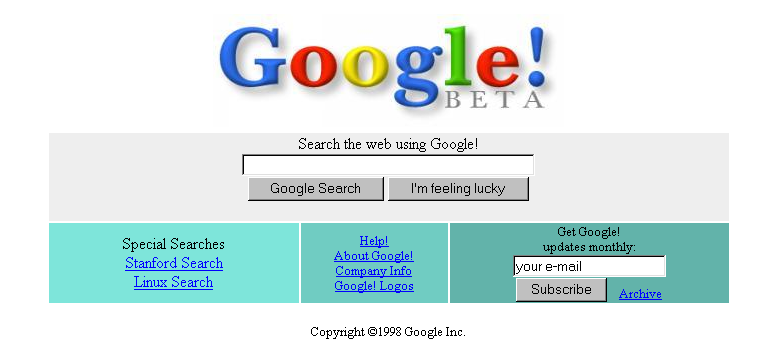
A good website builds loyal customers over time. Your website may not look as bad as Google’s did back in 1998 (although we have seen some that do come close!). Do you think Google would be as popular today if they didn’t invest in their website seriously over the past several years?
We Spent 10’s of Thousands on Our Website about 5 years
5 year is a lifetime in the digital world. Traditional civil engineering projects are often designed to last 100 years. You’re lucky if your website lasts 100 months without any input. Unfortunately spending money on digital projects does not guarantee quality. We’ve seen so many instances where companies have spent a lot of money on websites which simply haven’t delivered. Only recently have we seen a brand new website launched that is effectively telling Google to go away.
This is an unfortunate reality for many businesses, which is why we launched our Digital Lifeline packages so you can call on someone to give you solid advice about your digital activities and website technologies. Having bought a website years ago and wondering why this isn’t performing now is a little mad when you compare this to the real world. Imagine if you bought an old car from a sleazy second hand car sales man, you can picture the type, and then you decided not to get an MOT done at all, no services, any repairs were done with your own hammer, screwdriver, car manual and a bit of duck-tape where needed. How do you think your car would be performing today? Probably not very well.
Again, the same is true for your website. If you see your website as a cost, then you have already lost. If you see your website as a vehicle to increase ecommerce sales, enquiries from around the globe and ultimately revenue then you are on the right track. Imagine living out in the sticks, with only a post office and a corner shop in the village. Not a great deal of job opportunities (i.e. personal revenue). In this instance, buying a car isn’t a cost, buying a car gives you freedom to break into new markets such as cities and increase your personal revenue by getting a higher paid job. Your website is no different – when you invest in your website seriously.

Your Website Should Generate a Return on Your Investment
Have a think about this;
- If I asked you to give me a £1 coin right now, how many of you would pop one in the post to us? No-one? Why? We’re a great bunch of folk 🙂
- As a comparison, if I asked you to give me a £1 coin right now, and I would give you £2 back, how many £1 coins would you send us in the post? I’m guessing that you’d empty your bank account, right? Because you would double your money overnight.
The logic of investing in digital marketing channels is no different. The difference being between traditional marketing channels and digital marketing channels is that you can track every single detail in one of these channels, whereas you can track very little results in the other channel.
Looking at the famous quote;
“Half the money I spend on advertising is wasted; the trouble is I don’t know which half.”
I’d like to expand on this quote and be a tad facetious;
“Half the money I spend on advertising is wasted; It’s the offline half!”
Being able to track and understand how all of your marketing channels are performing will allow you to make strategic decisions to grow your business. Simply spending money aimlessly on activities that you’ve always done in business probably isn’t the best approach going forward, unless you are confident that this is already working for you.
Next Steps
We work with businesses of all shapes and sizes, some who are well versed in digital technologies and are needing support along their fast paced journey, and also companies who require a good amount of support as they are still at the start of digital journey. We will work with any business who requires our help and is ready.
The familiar quotes couldn’t be truer;
“You can lead a horse to water, but you can’t make it drink” – Quote
“When the student is ready, the teacher will appear” – Chinese proverb
“A journey of 1000 miles begins with a single step” – Chinese proverb
We’re ready to work with you and your company as soon as you are. All of the contents of this blog post are choices which people and businesses can make. People either choose to do something about their underperforming website and talk to us, or they choose to do what they have always done.
The more companies I personally speak with, the more I realise that success in the digital world is not down to our amazing work alone (although this does help!) but it is often down to the choices made by the individuals within either ambitious or struggling businesses.
Remember, all you need to do is ask we we’ll be there to help.

























